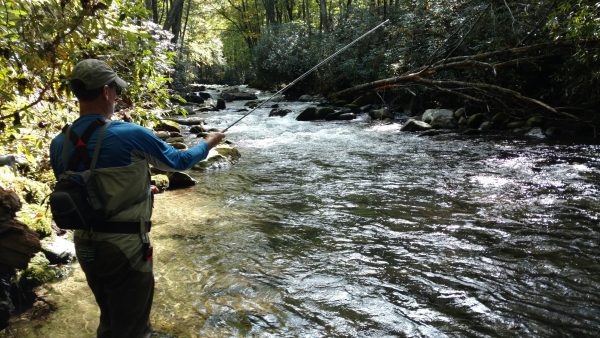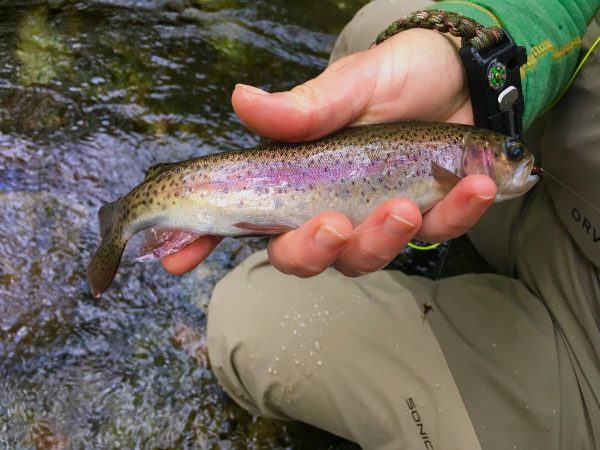It’s been a strange October when you do nothing but watch weather and water flows like we do. Almost the first half of October was exceptionally warm, flirting with record highs most days while we continued to wet wade well beyond our usual time frame. What would usually be a colorful riot of autumn color was nearly as green as what you’d see around Labor Day.
Then within barely a day and a half the weather turned cooler than normal. We watched as water temperatures on Little River fell about ten degrees in a little more than twelve hours. That’s an incredible amount of cooling in a stream and not something that tends to motivate the fish to eat. The sudden cool down has really jump started the colorful fall foliage, though.
We’re still catching fish, but it’s been a far cry from the incredible dry fly fishing we usually see in October. It’s also been a wet year, which is a very good thing for Smoky Mountain trout, but water levels are far above average for October, the typical lowest flows of the year. While I wouldn’t characterize our flows as “high”, they are certainly high for what we would see in October. Flows right now are more representative of earlier in the season like what we expect in April.

This is a recent photo from Little River upstream of Elkmont but flows resemble spring instead of autumn
The combination of cool weather and robust flows means we’ve relied on nymphs more than usual for autumn and also been fishing larger dry flies. Most years we fish #18 dry flies but this year we’re fishing significantly large #14’s to lure trout to the surface.
Right now the extended forecast seems to show a warm up so November may end up being more mild than October so the dry fly fishing could very well rebound before the arrival of winter. Regardless, fishing usually starts to slow down right around Thanksgiving; sometimes a little before and sometimes a little after. That means you need to get out now before fall turns to winter!


Gerald Cardwell says
Hello Ian, I enjoy reading your reports. Here is something I have been wondering about for a while. How long does it take a spooked fish to calm down and start looking for food? If I see a fisherman up stream a good piece from me, should I just go around him or can I expect to catch anything where he has been a few minutes before? I like to camp and fish Little River above Elkmont. Thanks!!
Ian says
Gerald,
There are a number of factors, but in mountain streams with wild trout in this part of the world we make it a point to skip water we know has been fished recently.
More water in a stream helps things recover quicker and a good hatch will also get fish back moving again, but regardless of whether the fish are “there” or not, they are more on guard and usually don’t act so hastily. I also feel strongly that a few casts in a spot where you haven’t waded will disturb the fish, but they seem to recover with some time. On the other hand, you can wade through a pool without casting at all and completely wreck it for some time. It’s all about how much the water was disturbed.
A few years ago I set up a GoPro in a very reliable spot where we can usually get a strike. I strapped the camera to a rock, waded out and left the rig right where fish would lie. There was about an hour of battery and disk space with the set up so I came back in time to make some casts. Not a strike at all and I concluded that the fish never came back after I waded in to set the camera.
Funny thing was that I eventually took a look at the video and the fish came back very quickly, in less than a minute. In fact, at the end of the video as I waded in to retrieve the camera I could see the fish move away from my approach but still remain visible to the camera as I pulled it up. That tells me that the fish pay more attention to what’s going on and are less likely to eat an artificial fly after they’ve been disturbed.